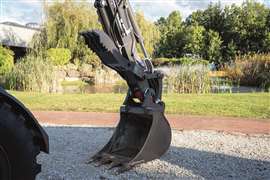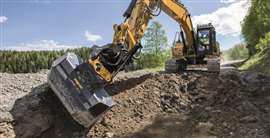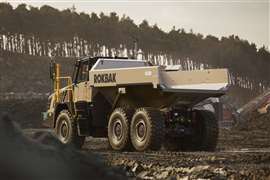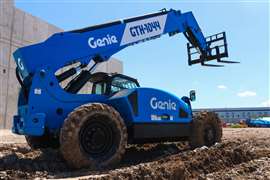Read this article in Français Deutsch Italiano Português Español
From sensors to tiltrotators: how attachments are getting smarter
01 September 2025
 A Develon DX260LC-9 excavator with a scoop bucket attachment (Image: Develon)
A Develon DX260LC-9 excavator with a scoop bucket attachment (Image: Develon)
The attachments market has traditionally operated in silos, with each equipment manufacturer making proprietary tools exclusive to their machines. But, Mitchell Keller reports, dealer and user demands are changing, as are the products.
Attachments are not just accessories; they’re at the heart of productivity, safety, and machine intelligence on any given construction site.
As operators demand more from every tool on the jobsite, manufacturers are responding with smarter systems, greater compatibility, and sharper regional strategies.
From global efforts introducing new interface standards to compact-friendly innovations and sensor-driven breakers, the attachment market is reshaping itself around flexibility and performance, which is a telling sign of the construction market to come. As competition grows, so does the pressure to deliver tools that work harder, fit faster, and integrate seamlessly across all fleets.
Opening the interface
A deliberate revolution is underway in how excavator attachments connect, and Sweden-based Steelwrist and Rototilt are leading the charge.
 Karl Serneberg, left, and Stefan Stockhaus at the World Demolition Summit in Stockholm, Sweden.
Karl Serneberg, left, and Stefan Stockhaus at the World Demolition Summit in Stockholm, Sweden.
The movement is called the Open-S Alliance (Open-S), an open-source interface standard launched in 2020 to ensure full compatibility between tiltrotators, quick couplers and hydraulic work tools, regardless of manufacturer. It challenges decades of proprietary systems by offering a common, safety-compliant interface that any OEM or supplier can adopt.
“The world doesn’t need another proprietary solution,” Steelwrist CEO Stefan Stockhaus tells International Construction magazine. “What it needs is compatibility and the freedom to choose.”
Stockhaus, who also chairs the Open-S board, says the goal was never to lock competitors out but to create a neutral platform that works for manufacturers, dealers and users alike. The standard governs the hydraulic and electronic interface between machine and tool, building on the existing ISO 13031 quick coupler safety standard while adding a consistent set of rules for full integration and plug-and-play functionality.
“It’s about more than safety; it’s about interoperability,” he adds.
Since its founding, Open-S has grown into a formal alliance supported by a rising number of OEMs, suppliers, and dealers. Members now include Volvo CE, Wacker Neuson, Kinshofer, and others, each committing to a shared interface that helps reduce tool lock-in and simplify inventory management. Indeed, 2024 marked something of a turning point for the movement.
Mecalac grows breaker range for compact carriers
 A Mecalac hydraulic scoop bucket attachment (Image: Mecalac)
A Mecalac hydraulic scoop bucket attachment (Image: Mecalac)
France-based Mecalac has expanded its hydraulic attachment line with a new series of breakers designed for compact and mid-size machines.
The MB30, MB40 and MB50 are now available for excavators between five and 12 tonnes, with a larger MB80 model targeting machines up to 16 tonnes. Each unit features internal dampening systems to reduce recoil and sound, and a no-load protection mechanism that prevents internal wear when not striking material.
Mecalac says the launch rounds out its commitment to offering full lifecycle solutions – from machine to attachment – for compact contractors working across tight or regulated environments.
“In 2024 alone, we doubled the number of Open-S members,” says Karl Serneberg, vice president of marketing and OEM sales at Steelwrist. “The conversation is shifting from ‘Why?’ to ‘When?’”
The pitch to industry is straightforward: adopting a common interface allows contractors to freely mix and match attachments, reduces complexity for rental and dealership networks, and gives machine operators more control over the tools they use. For OEMs, it opens the door to markets previously dominated by incompatible systems.
“It’s the USB-C of the attachment world,” Serneberg says, referring to the universal smartphone charging standard recently adopted across Europe.
Where previous thinking held that each brand required its own closed-loop attachment ecosystem, Serneberg says customers are increasingly asking for interchangeable options. “Contractors today are less brand-dependent. They want solutions that work across fleets, across models, across regions,” he says.
Open-S may also see faster uptake in newer markets like North America, where the lack of entrenched local standards could make it easier to adopt a universal model.
“In Germany, there are already four or five incompatible legacy systems,” explains Stockhaus, noting adoption of Open-S there has been difficult. “But in the US, it’s a clean slate. That makes it easier to go straight to the open standard.”
For the group’s leadership, it’s only a matter of time before the tipping point arrives. “If just one or two more big OEMs come on board,” Stockhaus says, “that would shift the entire market.”
Getting smarter about coupling
As operators expect more from their machines and the tools connected to them, manufacturers are working to embed smart technology and job-specific versatility directly into their attachment offerings.
At South Korea-based Develon, that strategy is evolving alongside the launch of its new ‘-9’ generation excavators, which includes sensor-driven functions designed to optimise tool use in the field.
“We are always looking forward to new opportunities in technology,” Paramvir Singh, attachment product manager at Develon, says. “Emerging systems of tool recognition help with correct setting and maintenance of attachments and also support sustainability and reliability.”
While universal recognition or automation standards are still developing, Singh says that the OEM is actively evaluating options. “We are looking into the possibilities and different approaches and evaluating which would be the best way to get into this trend.”
Recent machine releases already reflect that shift. New smart features for Develon’s excavators include Anti Blank protection and Smart Breaker settings, which help operators avoid misuse and tailor hydraulic output to the tool. The company has also prioritised quick coupler flexibility, rolling out a new dual-locking Pin Grabber coupler on its DX400HD-9 model. The system allows users to reverse bucket orientation – useful for pipe trenching and low-visibility digging – while maintaining ISO 13031 safety compliance.
 An Eddie 150 hydraulic breaker attached to a row of machines (Image: Eddie)
An Eddie 150 hydraulic breaker attached to a row of machines (Image: Eddie)
China-based Eddie, a specialist in attachments for infrastructure, demolition and mining, has also prioritised smart systems, integrating real-time sensing and automated control into its latest offerings. Its hydraulic breakers now feature a multi-stage valve that senses rock hardness and adjusts impact frequency on the fly, increasing energy efficiency while protecting the tool from damage.
“In the future, built-in sensors will enable real-time monitoring of equipment status,” Eddie tells International Construction. “This provides users with fault warnings to further reduce downtime.”
While Develon’s roadmap currently centres on tool recognition and machine integration, Eddie is taking a wider view of future development.
“The future of attachments will revolve around three major trends: intelligence, green technology, and modularisation,” the company says.
Eddie is experimenting with AI and big data to optimise performance, while incorporating energy-regeneration systems into its demolition tools to reduce fuel consumption.
Sweden-based Epiroc says it is sharpening the performance edge of its attachment range through engineering upgrades and digital integration. The company’s new EC 100 hydraulic breaker is now shorter, lighter, and easier to service, with a replaceable wear bushing and integrated nitrogen-piston accumulator.
 An Epiroc breaker, cutter, and magnet on excavators (Image: Epiroc)
An Epiroc breaker, cutter, and magnet on excavators (Image: Epiroc)
Also unveiled at Bauma 2025, Epiroc’s DP 3220 demolition pulveriser introduces faster jaw cycles, 35% better fuel efficiency, and full 360° rotation for more agile, job-specific material handling.
Epiroc has extended its compact offering with the ADC series of auger drills – designed for carriers between one and ten tonnes – and announced new telematics features for real-time attachment tracking and usage data.
For US-based Ignite Attachments, smart design isn’t just internal, it’s part of the user interface.
“Innovation in compact equipment attachments is accelerating,” says Darin Gronwold, senior product specialist at Ignite. “Fleet managers and business owners are prioritising smarter, more efficient tools that match the pace and complexity of their work.”
This shift is particularly evident among younger, tech-forward operators who expect digital guidance and plug-and-play compatibility from their equipment. In response, Ignite has introduced a suite of digital-first solutions to simplify the buying process, including its Fit Finder system, which cross-checks attachment compatibility across thousands of OEM specifications.
Caterpillar’s new cutting edges for wheel loaders

Caterpillar has introduced a new line of what it is calling Single Life Cutting Edges for its medium wheel loaders, aiming to enhance durability and simplify maintenance.
Constructed from through-hardened DH-2 steel, the new edges are thicker and offer wear life comparable to standard options, even in high-impact and abrasive conditions. They are compatible with Cat 950, 962, 966, 972, 980, and 982 loader series.
They feature a single-bevel design, eliminating the need to monitor wear for flipping, which Caterpillar said also reduces downtime. Additionally, it provides up to 45% more value for customers who do not currently flip their cutting edges, Caterpillar added.
The design also reduces throwaway material and offers up to 40% lower cost compared to legacy systems, depending on the loader model. The edges are also retrofittable to aftermarket buckets (with the same hold pattern).
Region by region
Usage patterns continue to diverge between compact and heavy machines, particularly across global markets. “Compact equipment is used in many more diversified ways,” Develon’s Singh says, “when you might want to use one machine for the whole job — from excavating, through compacting, to laying concrete and sweeping the site at the end.”
The demand for multipurpose performance, often driven by a limited pool of skilled operators, is pushing OEMs to design around flexibility. Singh notes that while heavier machines have historically used more dedicated tools, specialisation is accelerating there too. Develon now fields tailored models for material handling, demolition, and tunnelling, with car dismantling and recycling variants currently under development.
Global trends are also shaping attachment priorities. In Europe and South Korea, tiltrotator adoption continues to climb. “In the European market, especially in the Nordics and also in South Korea, we are seeing a trend of customers moving towards tiltrotators,” Singh notes.
Despite their higher purchase cost tiltrotators are gaining popularity because they reduce cycle times and help fill labour gaps. North America and emerging markets are seeing tiltrotator growth as well – albeit at a slower pace – as 3D analysis and digital measuring tools gain popularity across markets as operators seek more control and precision from inside the cab.
Eddie, by contrast, has focused on affordability and versatility in developing regions. In Asia, Southeast Asia, and Latin America, where urbanisation and infrastructure projects are surging, its modular strategy supports a wider array of applications on a single machine.
To meet a variety of coupler and safety standards, Eddie has developed a dual-track quick coupler offering: the S-series for the EU market includes dual mechanical locks and rollover protection per the EU Machinery Directive; the D-series, designed for the US and Australia, features a “triple-insurance” locking system to meet ANSI/OSHA dynamic load requirements.
“In Asia, cost-effectiveness and versatility are the primary concerns,” the company says, which is why its core components are highly interchangeable and external configurations are adapted per regional requirements.
The company is also investing in localised support and reveals that markets such as Southeast Asia, Africa, and Latin America are now among the fastest-growing for Chinese-made attachments, driven by infrastructure and mining activity.
Ultimately, the world of construction equipment attachments is about closing the loop; that is, removing barriers for dealers and users so they can better use valuable equipment on any type machine.
For Open-S Alliance, the mission isn’t about ownership, it’s about access. “This is about giving customers freedom, manufacturers reach, and dealers clarity,” says Serneberg. “Everyone benefits when attachments just work.”
Engcon expands quick coupler range, safety integrations
 An Engcon tiltrotator working a trench on an excavator (Image: Engcon)
An Engcon tiltrotator working a trench on an excavator (Image: Engcon)
Sweden-based Engcon extended its EC-Oil quick coupler system with new S40, S45 and S80 models, covering excavators from 3 up to 40 tonnes.
These new couplers build on the S70 model released earlier this year and are designed to increase hydraulic flow, eliminate hoses, and reduce oil leak risks. According to the company, all three are engineered to simplify tool switching while enabling full compatibility with Engcon tiltrotators and control systems.
In a separate development, Engcon has partnered with Israeli tech firm RodRadar to bring real-time underground utility detection into the cab. Starting in 2025, the Live Dig Radar system will be available as a retrofit upgrade for DC2 and DC3 tiltrotator models, enabling operators to detect buried cables and pipes automatically while digging.
STAY CONNECTED


Receive the information you need when you need it through our world-leading magazines, newsletters and daily briefings.
CONNECT WITH THE TEAM










